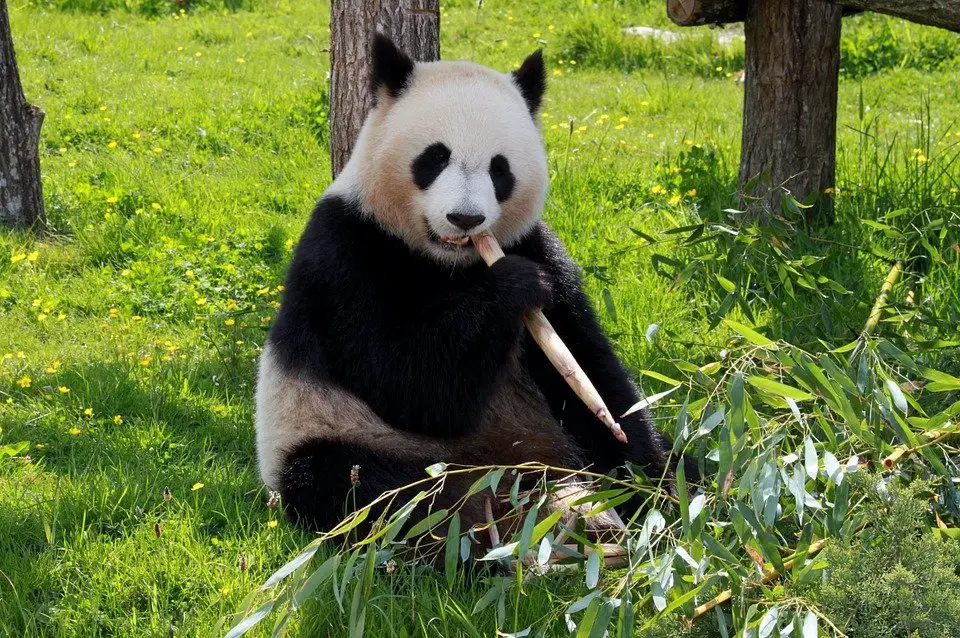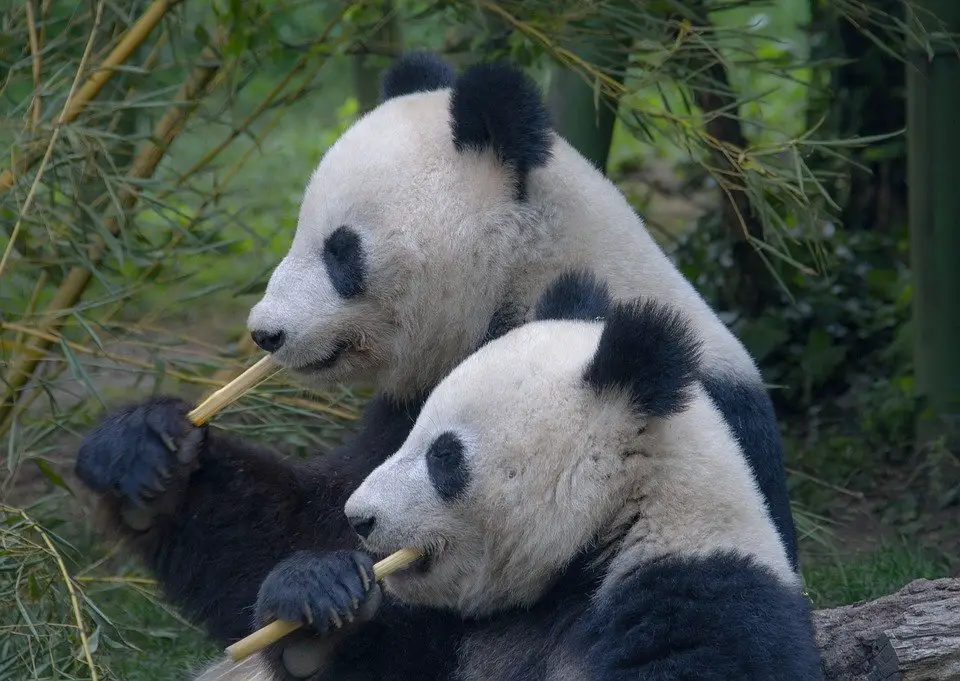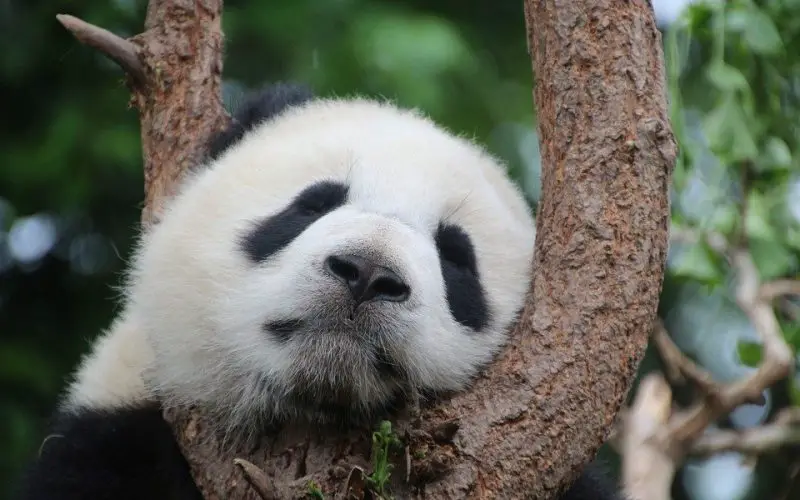Table of Contents Show
Pandas are some of the most lovable, popular and unique creatures on earth. This is largely due to their bold black and white coloration, with their ears, shoulders, muzzles, eyes, and legs all black while the rest of their body is white. Their thick hair allows them to remain warm during winters and in wet mountainous regions. They also have a very unusual omnivorous diet consisting of plant materials like bamboo, berries, other animals, fishes, and insects.
Characteristics of Pandas
Pandas are about 3 feet tall on four legs, 4-5 feet wide and weighing about 250-300 pounds with the males being larger than the females. Pandas have a protruding wrist bone that may act as a thumb allowing them to grip their food. The most important food in their diet is bamboo and that is almost all they eat! They eat bamboo for about 12 hours! Pandas can start reproducing at an age between 4-8 years. However, the fertility period of female pandas is very limited, lasting for 2-3 days each spring season. Pandas live up to 15-20 years in forests and 30 years if they are kept in conservation facilities. Conservation efforts are one of the goals of Environmentbuddy.
Unfortunately, these endangered pandas are also facing the very real possibility of becoming extinct. The pandas are considered vulnerable to extinction by the IUCN. Here we will highlight the reasons why Pandas are endangered in today’s world.
Reasons why Pandas are facing Endangerment
Habitat loss
The biggest reason why pandas are facing endangerment is deforestation activities by humans, leading to permanent habitat loss and destruction. Pandas used to roam through various forests of Laos, Burma, Vietnam, and China. Unfortunately, they are now only restricted to some regions of China, and that too in a far fewer number than ever before.
Just like other organism, loss of habitat for pandas spells doom as more and more bamboo forests are being cleared away. Bamboo forests are being cut down which means pandas are losing their most essential food source.
Relocation is difficult as forests, although still present, are far away from each other due to urbanization of areas between them. Without proper access to food, pandas may perish from starvation.
Pandas have a hard time adapting
Due to ever-increasing human activities in wildlife areas, animals have found it difficult to adapt. Many animals can become adapted to such human activities; but some, like pandas, cannot adapt that quickly. They simply can’t relocate into cities or towns once their natural habitats have been destroyed, nor can they shift away from their preexisting diet, which as we discusses is bamboo stalks.

This is partly due to the digestive system of the pandas as well. Their body is prone to consuming bamboo only. Even though there is limited nutritional value in bamboo plantations, they still consume it in large amounts. An average-sized panda consumes nearly 20 to 40 pounds a day.
Reproduction issues
Most bear species give birth to one to three cubs at a time with only one cub surviving till childhood. This is even worse for pandas, as their bodies are not well-equipped for pregnancy due to their low-nutrient bamboo diet.
The amount of nutrients present in a mother panda are limited to give birth to a single cub only. If two or more cubs are born, the mother may be forced to abandon one of the cubs. This is because her milk has the lowest amount of nutritional quantity as compared to any other mammal, making it impossible for her to feed two of her cubs.

Pandas that are poached and subsequently captivated are also impossible to breed. Pandas are unusually very picky in choosing their mates even if they are kept close together, meaning there is no guarantee they will even mate through their lifetime.
If the pandas do end up mating in captivity, the cubs need to be raised by people as the mother pandas may choose to abandon their offspring in captivity. This has made it very difficult for panda conservation programs to be successful due to pandas’ highly selective diet and mating rituals.
Poaching
Pandas are one of the most commonly poached animals in the world which has made them susceptible to becoming extinct. Pandas are illegally poached for their skins and pelt. Hunters are able to make a pretty good sum of money from pandas in the black market. With wildlife numbers being at an all-time low, even the death of a single panda is considered a tremendous loss.
How has China Protected and Conserved Pandas?
China has worked tirelessly to protect their lovely pandas from becoming extinct. Various efforts have been carried out by the Chinese government concerning this issue. They have started to protect the habitats.
The Chinese government has set up 13 panda reserve areas free of human interactions so that they may become forests. Trees and bamboos have been made available to pandas, allowing their numbers to expand.
According to a research conducted by the Chinese government in 2015, there has been a growth of about 2,720 square kilometers of habitat for giant pandas.
Captive breeding programs have been carried out in order to increase the population of these animals. Panda research centers have been established with the primary focus being on research and breeding of these animals. Several of these centers also educate people about the protection of panda species. Some of these captive breeding programs have released many pandas into the wild once they are ready to do so.
According to China’s Wild Animal Protection Law, Panda are classified as a “first class protected species”. This is because China considers Pandas to be the “natural treasure of China”. The Chinese government has established strict laws and penalties concerning the illegal trading and poaching of these animals. People can face a hefty fine and up to ten years in prison and sometimes even death penalties.
Due to these efforts, On September 5th, 2016, the IUCN announced that giant pandas had been removed from the endangered list. Now their new designation is “vulnerable”.
Environmentbuddy aims to protect and conserve pandas as much as it can, you can support our cause here.






